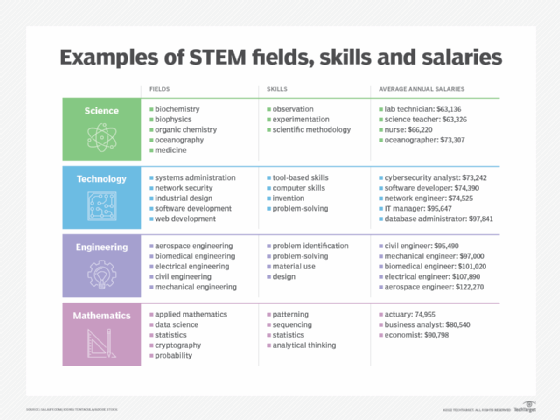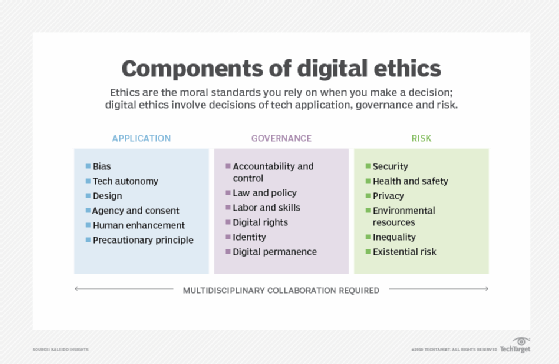
Getty Images
6 reasons why diversity in STEM is important
Diversity in STEM industries brings together different perspectives, creates a better experience and generates better results.
Science, technology, engineering and mathematics is a broad educational program that spills over into many industries and technologies, affecting everyday life.
Yet, the STEM industries are still heavily biased in some areas. According to data from the Pew Research Center, the STEM workforce is predominantly white. Women are also heavily underrepresented in some STEM fields. Only 25% of computer jobs and 15% of engineering jobs are occupied by women. This bias reinforces stereotypes in the minds of the public. Out of 4,000 survey participants asked to imagine a doctor's gender, only 5% presumed that the doctor would be female.
The STEM industries should have an equally diverse workforce to provide a true social benefit. The importance of diversity in STEM should be the primary focus for many reasons.
1. Equity
Diversity, equity and inclusion (DEI) -- in STEM or any other field -- gives people of different identities and backgrounds an opportunity to participate and contribute their perspective. Everyone has something of value to contribute, and it's the responsibility of society -- more specifically the organizations that hold power within a society such as corporations and governments -- to make sure that everyone has equal opportunity to contribute. Providing access to STEM education and STEM careers helps alleviate disparities and advances social equality.
Achieving equity and inclusion also ensures that systems of the future adhere to an ethical standard. Take AI for example. It's important to build AI systems with cultural diversity and equity at its core so that they make decisions based on an ethical foundation. AI systems need to be designed not to omit data because some data points seem atypical. The biases of a nondiverse development team could be hard coded into an AI system that has the power to perpetuate those potentially harmful biases at scale. For example, an AI system that evaluates insurance claims or credit scores.

2. Creativity and innovation
A team of people with different cultures and backgrounds who all see the world in a different way benefits creativity. Different perspectives and information enable teams and companies to break old ways of working and develop new ones that were previously obstructed by myopic, overtrodden approaches to problems. Many cultures, identities and life experiences translate to a wide breadth of information and cognitive diversity. This creates a more well-rounded and flexible approach to problem-solving. More diverse teams of problem-solvers outperform groups of high-ability, homogeneous problem-solvers, according to a study published in the Proceedings of the National Academy of Sciences.
STEM is an area that needs creative innovators, and companies can't afford to limit their perspective by only approaching problems one way. STEM enables the generation of new technological and scientific insights. Cognitive diversity can enhance team innovation by up to 20%, according to a study from Deloitte.
3. Skills
There is always a need for STEM skills. The demand for computer and information research scientists is expected to increase by 21% between 2021 and 2031, according to the U.S. Bureau of Labor Statistics. This statistic doesn't indicate a skills shortage but does show a progressively increasing demand for STEM workers. A lack of diversity in STEM has the potential to stunt this expected growth.
STEM education is also how countries remain globally competitive. Of the 10 fastest growing federal occupations in the U.S., nine out of 10 jobs were STEM related, with statisticians in the No. 1 spot at 23%. Building STEM skills starts young, and so should squashing STEM stereotypes. The hope is that this offsets currently uneven progress in STEM degree attainment across gender, racial and ethnic lines.

4. Positive work environment
Diversity in STEM also contributes to worker morale. Employees who work at companies with strong DEI programs are generally happier in their jobs and trust management more. Company culture that fosters inclusion of diverse groups of people from different backgrounds offers many benefits. Inclusion makes workers feel safe to speak up without fear of retaliation or embarrassment and feel empowered to do their best work.
Seventy-eight percent of U.S adults surveyed said it was important for them to work at an organization that prioritizes workplace diversity, according to a 2021 CNBC|SurveyMonkey Workforce Survey. Six out of 10 workers in the U.S. said they approve of business leaders speaking up about social and political issues. If diversity and inclusion are prioritized and an inclusive environment is fostered -- especially in leadership -- workers will want to stay with a company and have a better experience doing so. In return, the company will have better workforce retention and less employee turnover.
5. ESG
Diversity and inclusion initiatives are also part of a company's overall environmental, social and governance (ESG) agenda, as part of the governance portion. Governance examines how a corporation polices itself to conduct business ethically. A company might disclose in their ESG reports the diversity and structure of the board of directors, which makes decisions for the company. They might also disclose other diversity initiatives, such as releasing workforce demographic metrics, offering anti-bias training to new hires or offering community mentorship programs. Stakeholders and investors want to work with ethical companies. Demonstrating diversity in both board composition and hiring practices is one way to appeal to them.
Science and technology fields may have long upheld the idea that these fields are inherently objective and unbiased, but demonstrating diversity and inclusion can boost value, credibility and appeal to stakeholders. Supporting STEM education initiatives also enables companies to generate social value and develop a more diverse talent pipeline and subsequent diverse workforce.
6. Bottom line
Talent is the central parameter to any company's growth, and the benefits of DEI programs help companies reach their bottom lines and improve financial performance. By creating a diverse environment with a positive effect on employees, companies can achieve higher levels of scientific success and ultimately help the company profit. Companies in the top quartile of executive team gender diversity were 25% more likely to have above average profitability than companies in the bottom quartile, according to a 2019 McKinsey analysis.
Having diversity in all levels of management impacts productivity as well. Tech firms with matching racial diversity in upper-level management and lower-level management had superior productivity to those that had nondiverse management in both tiers, according to 2021 research published by the Academy of Management.








